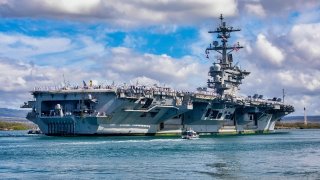The U.S. Navy Has No Aircraft Carriers in the Middle East Right Now
The USS Abraham Lincoln (CVN-72) has left the Middle East, marking only the second time in over a year that no U.S. Navy aircraft carriers are present in the region.
What You Need to Know: The USS Abraham Lincoln (CVN-72) has left the Middle East, marking only the second time in over a year that no U.S. Navy aircraft carriers are present in the region.

-The USS Carl Vinson (CVN-70) has deployed to the Pacific, while the USS Harry S. Truman (CVN-75) may head to the Middle East after completing NATO exercises in the Arctic and Mediterranean.
-Despite the absence of carriers, the U.S. has bolstered its presence with B-52 bombers, F-16s, F-22s, A-10s, and the amphibious assault ship USS Wasp (LHD-1).
-Additionally, the USS Georgia (SSGN-729) submarine remains in the region, ensuring significant firepower to counter threats from Iran and its proxies.
No Aircraft Carriers in the Middle East: U.S. Navy Shifts Focus Amid Global Tensions
The United States Navy announced on Monday that the Abraham Lincoln carrier strike group departed from the Middle East and entered the U.S. 7th Fleet of operations, USNI News first reported.
It is just the second time in more than a year that the U.S. Navy has had no carriers operating in the Middle East. The first time was briefly in June when USS Dwight D. Eisenhower (CVN-69) entered the Mediterranean via the Suez Canal while USS Theodore Roosevelt (CVN-73) was en route from the western United States.
USS Abraham Lincoln (CVN-72) was rushed to the region in August, joining CVN-73 – allowing an overlap of carriers, as Washington sought to deter Iran and its proxies as Israel remains engaged in fighting with Hamas in Gaza and Hezbollah in southern Lebanon.
USNI News also reported that the Carl Vinson Carrier Strike Group "quietly deployed from California for a Pacific deployment," but it is unlikely the Nimitz-class nuclear-powered supercarrier and escorts will head to the Middle East – and it would still take weeks for them to reach there. A U.S. Navy spokesperson only said that the carrier would take part in "routine operations in the 3rd Fleet area of operations."

Could Another Carrier Head to the Middle East?
It is more likely that the Harry S. Truman Carrier Strike Group will head to the Middle East, as it recently concluded joint operations with NATO partners in the Arctic Circle off the coast of Norway, and on Monday was steaming to the Mediterranean Sea.
Last month, USS Harry S. Truman transited the Straits of Dover and took part in operations with NATO partners in the North Sea. It was the first time the flattop named for the 33rd president had operated in the region since 2018.
CVN-75 was also last deployed to the Eastern Mediterranean in early December 2021 as part of the Department of Defense's (DoD's) response to the then-anticipated Russian invasion of Ukraine. The carrier remained in the region until September 2022, spending 285 days deployed.
Even as there are currently no U.S. Navy carriers in the region, the Pentagon has increased the presence of U.S. aircraft and earlier this month rotated B-52 Stratofortress bombers to the region, adding to the force of F-16 Fighting Falcons, F-22 Raptors, and A-10 Thunderbolt II that were previously deployed. Those aircraft are operating from multiple undisclosed air bases.
In addition, the U.S. Navy's amphibious assault ship USS Wasp (LHD-1), her amphibious ready group, and the 24th Marine Expeditionary Unit remained positioned in the Eastern Mediterranean. In August, the U.S. Navy also announced that it had deployed the Ohio-class guided-missile submarine USS Georgia (SSGN-729) to the region – a rare public admission of the whereabouts of submarines that are designed to silently and secretly patrol the world's oceans.
Even without a carrier – at least for now – Washington has ensured there is a lot of firepower present to respond should Iran or its proxies make an ill-planned move.
Author Experience and Expertise: Peter Suciu
Peter Suciu is a Michigan-based writer. He has contributed to more than four dozen magazines, newspapers, and websites with over 3,200 published pieces over a twenty-year career in journalism. He regularly writes about military hardware, firearms history, cybersecurity, politics, and international affairs. Peter is also a Contributing Writer for Forbes and Clearance Jobs. You can follow him on Twitter: @PeterSuciu. You can email the author: [email protected].
Image Credit: Creative Commons and/or Shutterstock.
From the Vault


